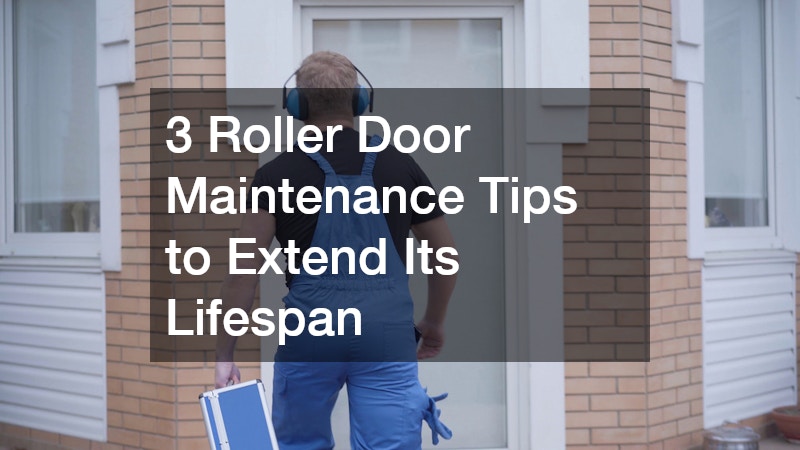A well-maintained roller door is vital for security, convenience and long-term performance in both residential and commercial settings. From home garages to warehouse entries, roller doors are constantly in use and exposed to the elements.
Without proper care, even the most robust system can suffer from wear and tear, leading to breakdowns, safety concerns or costly repairs. Fortunately, regular maintenance can go a long way in preserving the lifespan of your roller door and ensuring it continues to function smoothly every day.
Below are three essential roller door maintenance tips that every property owner should follow. These straightforward steps can help you avoid unnecessary issues and maximise the value of your investment.
Keep the Tracks Clean and Free of Debris
One of the most common causes of roller door malfunction is blocked or dirty tracks. Over time, dust, dirt, cobwebs, leaves and even small stones can accumulate within the tracks, disrupting the movement of the door. This buildup can lead to a grinding noise, jerky operation or a door that gets stuck halfway. Left unchecked, it can also place extra stress on the motor or manual mechanism, accelerating wear.
To maintain the tracks, start by visually inspecting both the interior and exterior sides for any visible debris. Use a stiff brush, vacuum or compressed air to remove dirt and foreign objects. A damp cloth may help with more stubborn grime, but be careful not to introduce too much moisture into the tracks, especially if they are made of steel. Excess water can contribute to rusting, particularly in coastal areas with salty air.
Additionally, always ensure the tracks remain straight and properly aligned. If you notice warping, dents or misalignment, call in a professional to carry out adjustments. Operating the door on damaged tracks can lead to further issues and unsafe operation. A clean and straight track system ensures your roller door glides smoothly with minimal strain on its components.
Lubricate Moving Components Regularly
Another key aspect of roller door maintenance is regular lubrication of all moving parts. Without proper lubrication, metal components can grind together, leading to squeaking noises, jerky motion and eventual mechanical failure. Friction from dry hinges or rollers also increases the effort needed to operate the door, putting extra load on the motor or manual mechanism.
Lubricate all hinges, springs, rollers and pivot points with a silicone-based lubricant specifically designed for garage or roller doors. Silicone products are ideal because they don’t attract as much dust and dirt as oil-based sprays. Avoid using WD-40 or heavy greases, as these can gum up the components and cause further issues.
Before applying lubricant, gently clean the parts with a cloth to remove old grease and dust. Apply the lubricant sparingly and move the door up and down a few times to distribute it evenly. Pay particular attention to the tension springs, which bear the weight of the door and are essential for smooth operation. However, adjusting or replacing springs should always be left to professionals due to the risk of injury from high tension.
Routine lubrication—at least every six months—ensures your roller door runs smoothly and reduces the risk of early wear on vital components. It’s a simple task that takes just minutes but can extend your door’s service life significantly.
Inspect and Test the Door Mechanism
In addition to cleaning and lubricating, regular inspections are essential to catch problems early. Visual and functional checks can alert you to loose parts, signs of corrosion or changes in performance. Ignoring small issues often leads to bigger problems that require expensive repairs or part replacements.
Start by examining the door panels, brackets and fasteners. Look for loose screws, rust, dents or cracked hinges. Make sure the door opens and closes without resistance. If the door is motorised, listen for any unusual noises such as grinding or screeching, which can indicate a motor strain or component failure.
Test the balance of the roller door by manually lifting it halfway. If it does not stay in place or feels unusually heavy, the spring system may be worn or misaligned. This is a job for a trained technician, as spring adjustments can be dangerous without proper tools and experience.
For electric roller doors, test the automatic safety reversal system. Place a lightweight object, such as a small block of woo,d under the door as it closes. It should reverse immediately upon contact. If it doesn’t, your safety sensors may be misaligned or faulty, posing a hazard that should be addressed promptly.
Taking care of your roller door doesn’t have to be difficult or time-consuming. With regular cleaning of the tracks, proper lubrication and routine inspections, you can keep your door operating efficiently and safely for many years. These simple maintenance tasks reduce wear, prevent costly repairs and improve the door’s overall performance.
Whether you’re managing a residential property or a busy commercial site, a well-maintained roller door contributes to your security and daily convenience. For anything beyond basic upkeep—such as alignment issues, spring replacement or motor repairs—it’s best to consult a professional service. Their expertise ensures the job is done safely and effectively.
By adopting a consistent maintenance routine, you can protect your investment and enjoy smooth, trouble-free operation of your roller door in all seasons.

